Traumatic Injuries
Playlist includes 9 training videos
Traumatic injuries often require first aid providers to provide assistance. It is important for first aid providers to know how to respond to different situations. Assisting more skilled providers in delivering care as well as providing initial care are two of the most valuable contributions of first aid responders to helping seriously injured persons.
Controlling Bleeding
The most attention usually goes to blood loss. Even when more serious injuries should be handled first, bleeding is usually overestimated, as it draws attention to the wounds. Make sure nothing more serious is being overlooked by conducting a quick overview of the situation whenever you are confronted with bleeding.
In caring for a bleeding and injured person, always use personal protective equipment. As you begin putting on your protective gear, the injured and bleeding person can be directed about how to perform basic self-care while waiting for your help.
Applying direct pressure is the best way to stop bleeding from a wound. Press firmly to apply direct pressure to the wounded area with a gloved hand and a dressing. Hold and wait until the bleeding stops. Always apply pressure to the worst injuries first, then to lesser wounds, when there are multiple bleeding injuries. You may ask the injured person to assist temporarily in holding pressure if there are too many areas to treat.
An antibiotic salve can help heal smaller wounds like scrapes more rapidly. Before applying the salve, ask the person if they have any allergies. If they do have allergies, do not apply the salve. Before bandaging, use soap and water to wash minor scrapes and abrasions.
Open fractures and deep lacerations are examples of extreme injuries from which massive bleeding can occur. Some events may require a tourniquet if bleeding is not controlled by direct pressure. Premade commercial versions, belts, and even a blood pressure cuff can be used as tourniquets. A self-made tourniquet can be made rapidly with a piece of cloth and a stick-like object if no commercially prepared tourniquets are available (though commercial versions are more effective).
Tourniquets are sometimes necessary to prevent fatal blood loss, though applying them can be painful. If used incorrectly, tourniquets are difficult and dangerous to use. Always try direct pressure first.
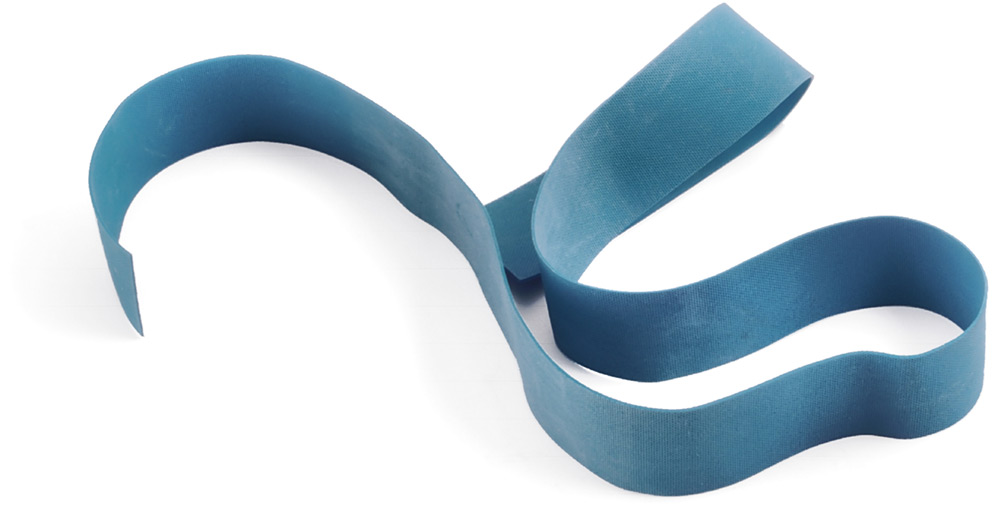
Figure 6
Do the following to apply a tourniquet:
- Wear personal protective gear.
- Apply the tourniquet approximately 2 inches above the wound.
- Tighten until the bleeding stops.
- Check and take note of the time when the tourniquet was applied.
- Call 911/EMS.
- Until advanced help arrives, wait with the person and do not release the tourniquet.
When examining a person visually, remember that some situations can produce massive internal bleeding that you may not see. Crush injuries, car accidents, falls from a height, and trauma is some of these situations. Devastating internal bleeding with a small amount of external blood loss can be caused by penetrating injuries like a gunshot or a knife wound.
When such internal injuries are suspected, immediately call 911/EMS. Keep the person still and help them lie down. Check for signs of shock. Keep the person from getting cold by covering them. Wait with them until advanced help comes.
Teeth Injuries
When handling another person’s teeth, always use gloves, as the teeth may be chipped or broken, or sometimes completely knocked from the mouth.
When transporting the person to the medical facility or dentist, their teeth should travel with them, as these can sometimes be re-implanted. Avoid touching the roots when handling teeth; always be gentle. Never scrub the tooth or the roots, but you may gently wash it with clean water. Storing in milk, saline solution, or under a tongue are viable options for transporting a tooth. The person must see a dentist or medical provider as soon as possible.
Call the dentist and have the person bite down on a piece of gauze if dealing with a loose tooth. It can be quite painful to deal with cracked or chipped teeth. To prevent loss of the tooth when blood is visible at the crack, the person requires prompt dental care. Teeth that have an injury to the nerve may later begin to change color, requiring a trip to the dentist.
Nosebleeds
Often quite dramatic and messy, nosebleeds require you to wear proper eye protection and personal protective equipment when performing first aid. You should always prepare for the worst, as vomiting may occur when people with nosebleeds swallow too much blood.
First, put on your protective equipment and assess the safety of the scene. Afterward, for a minimum of 5 to 10 minutes, apply pressure on both sides of the nostrils just below the bony portion of the nose. Hold for an additional 10 minutes if bleeding persists. Sit upright and lean your body and your head slightly forward. This will keep the blood from running down your throat, which can cause vomiting. (Do NOT lay flat or put your head between your legs.) Seek further medical care if bleeding still persists. Call 911/EMS immediately if there are signs of severe distress or troubled breathing.
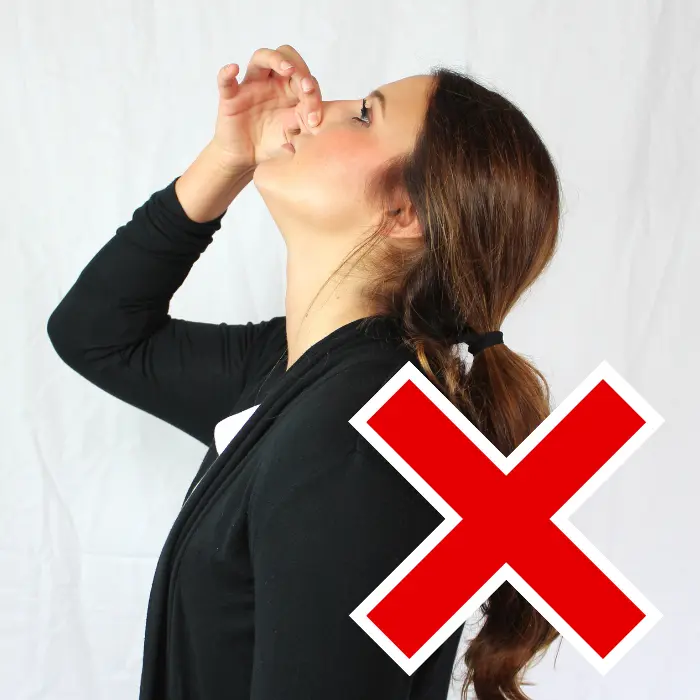
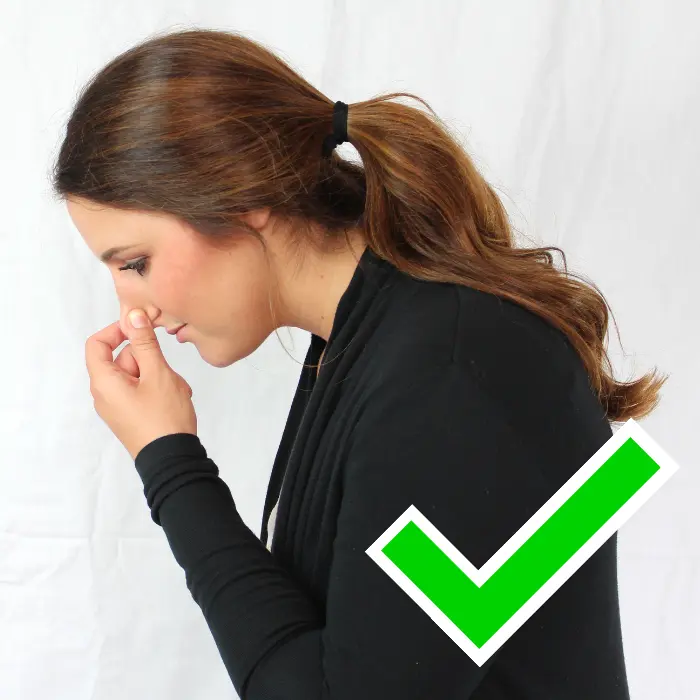
Figure 7
Punctures and Impaled Objects
The injured person is at a special risk from impaled objects and puncture wounds. Sensitive structures such as blood vessels, tendons, muscles, or nerves may be injured by puncture wounds, which usually penetrate deeper than is apparent. Seek further medical attention after you use direct pressure to control the bleeding from puncture wounds. Serious infections can be caused when puncture wounds carry germs deep into a wound. A professional must therefore evaluate the puncture wound immediately.
Do not remove an impaled object. This may result in massive blood loss from an injured blood vessel, as the object may pinch off the blood vessel and prevent bleeding until it is removed. Transfer the person to the emergency department while using gauze and dressings to stabilize impaled objects.
Eye Problems
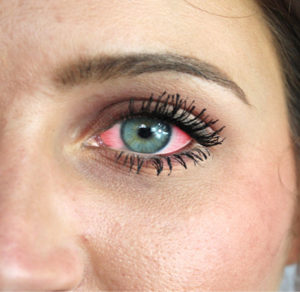
Figure 8
Inadvertent scratching of the eye, foreign bodies, and direct blows are some of the causes of common eye injuries. Redness, changing vision, tearing, and immediate pain are some of the symptoms of this type of injury, as well as bleeding and bruising from punctures and lacerations, and other more serious injuries.
Water can be used to flush away dust, debris, and other simple irritants. You should call 911/EMS if the eye comes in contact with any chemical, and also flush with a lot of water. Professional care is important, as adequately irrigating the eye sometimes requires special equipment.
Call 911/EMS if you suspect there is a more serious injury to the eye. A bandage or eye shield is enough to protect both eyes. You must cover both eyes, as leaving one eye uncovered still forces both eyes to move as one eye looks around because eyes work in pairs; it is essential to minimize the damaged eye’s movement. If a person has both eyes bandaged, never leave them alone. They require reassurance and verbal cues about their environment. To evaluate serious eye injuries, a skilled physician specializing in eye care is needed.
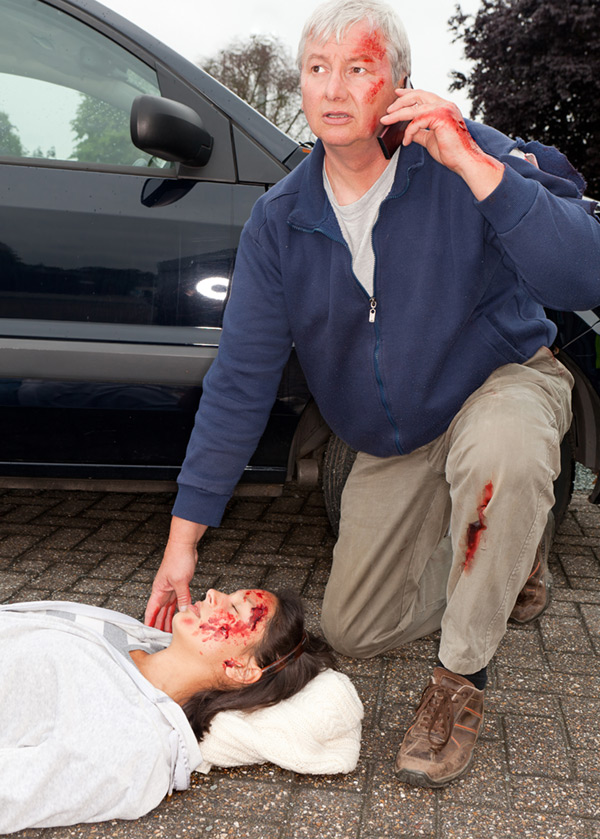
Figure 9
Head Injuries
Any traumatic event may cause head injuries.
Signs and symptoms of a head injury or traumatic brain injury include:
- Loss of consciousness
- Loss of balance and coordination
- Nausea and vomiting
- Seizure
- Headache
- Memory loss
- Confusion
A physician must evaluate any person demonstrating any of the above symptoms. Decreased productivity and loss of function are just some of the lifelong consequences that can be caused by head injuries. In more severe cases, permanent disability may occur.
While preparing the person for transport to advanced medical care, stabilize the head and neck manually to protect them from further injury. Changes in condition may occur, so observe closely. If the person becomes unconscious, be ready to start CPR.
 Spine Injuries
Spine Injuries
A car accident, diving, a fall, a sporting event, or most other physical activities can all lead to spine injuries. Spine injuries and head injuries sometimes come in pairs. To protect against further injury to the spinal cord and spine, you must maintain a high index of suspicion.
These factors increase the risk of a spine injury:
-
Older than 65 years
-
Substance use or intoxication
-
Experiencing weakness, tingling, or numbness
-
Fall from heights
-
Pain in the midline of the neck or back overlying the bony prominences
-
Car accident
-
Bicycle or motorcycle crash
-
Other distracting pain
Spinal injuries can often be very unstable. Permanent paralysis and spinal cord injury could be caused by unnecessarily moving the person. Do not bend, flex, or twist the person’s neck or head while performing first aid on someone with a suspected spine injury. Stabilize them with both hands placed on either side of the neck and head if they begin vomiting, and help them to their side. Call 911/EMS as soon as possible. Until advanced help arrives, keep the person stabilized.
Bone and Joint Injuries
Common occurrences in daily life, bone, and joint injuries can be experienced by physically active people and people playing sports. Breaks, strains, and sprains are also commonly experienced by the disabled and elderly, who are at high risk of falling. When a joint is stretched beyond its normal range of motion with abnormal motion or excessive force, sprains occur. Pain, bruising, and swelling are frequently caused by a sprain, but without an X-ray, it is impossible to rule out a fracture.
The first aid care for both sprains and broken bones includes the following:
- Wear protective equipment and make sure the scene is safe.
- For any open wounds, apply gauze.
- For up to 20 minutes apply an ice pack to the injured area.
- Avoid use of the injured part, and encourage further evaluation by a health care provider.
If any of the following are present, call 911/EMS:
- Open wound over a joint
- Bent extremity or abnormal position
- Obvious joint dislocation
Consider the following special circumstances:
When the bone breaks through the skin, an open or compound fracture occurs. Straightening the extremity and/or pushing the bone back in are not recommended; bones in these abnormal positions require splinting. An abnormally positioned bone or join should not be manipulated or corrected.
Protecting an injured extremity requires a splint. Rolled-up towels, pieces of wood, or rolled-up magazines can make a temporary splint. If possible, use a towel or cloth to pad the injured extremity. Use tape or gauze to secure the splint material in place; the material which should be placed on either side of the injured extremity. The fingertips or toes should still be warm and pink in a splinted extremity, so don’t make the splint too tight. Seek immediate care.
If a part of someone’s body is accidentally cut off, this is called an amputation. Always transport the body part to the hospital with the person, as sometimes surgeons can reattach it.
Do the following when dealing with an amputation:
- Put on personal protective equipment, get the first aid kit, and assess the scene’s safety.
- Call 911/EMS and activate the emergency response system.
- Use gauze to apply direct pressure to the bleeding area.
- Use the instructions below to care for the amputated body part.
- Wait until the arrival of advanced care.
Do the following when caring for an amputated part:
- Put on personal protective equipment.
- Locate the amputated body part.
- Use clean water to gently rinse it.
- Wrap it in gauze, then seal it in a place bag.
- Place the first bag in a second bag that has been filled with ice, then seal the second bag.
- On the bag, write the person’s name.
- Transport both the amputated part and the person to the hospital.
Burns and Electrical Injuries
Direct contact with certain chemicals, electricity, or any heat source can cause burns. While some burns are minor superficial wounds, very deep burns can damage bones, nerves, tendons, and muscles. Devastating and sometimes fatal injuries can be caused by high-voltage electrical injuries. The emergency department must evaluate anyone who has sustained an electrical injury.
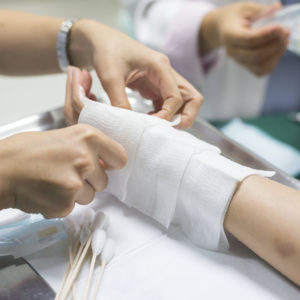
Figure 11
Do the following to treat small burns:
- Assess the safety of the scene by ensuring that the burn’s source is gone.
- Get the first aid kit and put on personal protective equipment.
- Use cool or cold water to rinse the burn.
- If no allergies exist, apply antibiotic or burn cream.
- Use a clean, dry non-stick dressing to cover the burn.
- Encourage the person to seek a health care provider.
Applying ice to a burn may will cause further tissue damage as it will result in a cold injury on top of a burn.
Call 911/EMS if you observe:
- A large burn
- Burns on someone’s genitals, hands, or face. Special treatment is required for skin over joints like the backs of knees, as healing will be complicated by constant motion.
- Troubled breathing
- A fire
- Potential carbon monoxide exposure
The best way to put a fire out is through “stop, drop, and roll.” Instruct the person to stop, drop to the floor, and roll to put out the fire. To extinguish flames, you can also throw a wet blanket on top of the person. After the fire is out, remove the blanket.
Do the following when caring for a person with a large burn:
- Ensure the safety of the scene.
- Call 911/EMS.
- Get the first aid kit and put on your personal protective equipment (PPE). Remove jewelry and clothing from the person.
- Remove any part of the clothing which is not stuck, and if you have suitable alternative coverings, i.e., a clean plastic film, sheet, blanket, etc., cover them. Do not remove clothing that is attached to their skin as it may tear the injury further.
